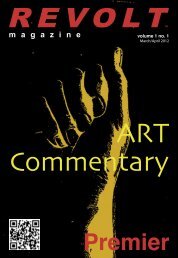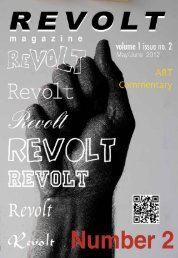Download PDF Version Revolt Magazine, Volume 1 Issue No.4
Download PDF Version Revolt Magazine, Volume 1 Issue No.4
Download PDF Version Revolt Magazine, Volume 1 Issue No.4
You also want an ePaper? Increase the reach of your titles
YUMPU automatically turns print PDFs into web optimized ePapers that Google loves.
On Being Post-Sequin<br />
continued...<br />
the city. Because it was part of a public art festival<br />
they kind of backed me with verbal support and<br />
positive vibes. I did get permission from the three<br />
people that owned the house that I was working<br />
with. For me that was really important as it was<br />
private property and it was someone’s home. I<br />
was very respectful of that but I didn’t even think<br />
about applying to the city. I don’t know if it would be<br />
possible now but at that time it was. As a contrast<br />
for my recent project in Russia I was invited by a<br />
public art fund under a newly established art<br />
museum in Perm. The Museum functioned also as<br />
a producer so I didn’t even come near any of the<br />
regulation and permission problems but I think it’s<br />
a completely unimaginable bureaucracy. So I’m not<br />
actually sure where the United States falls in that<br />
spectrum, but I imagine it’s somewhere in between.<br />
for granted? Why do we take this system for<br />
granted? There could be a million other variations.<br />
TH: Yes, I think that was also embedded in your<br />
question. I am interested in creating these kind of<br />
in-between zones where energy stands still between<br />
values associated with something being beautiful.<br />
Something that I thought a lot about in connection<br />
with the Russian commission were these Hal Foster<br />
and Miwon Kwon aspects. All these ideas of the<br />
itinerant artist and the artist who comes to a site<br />
KC: What is your process when you work on some of<br />
these large-scale site-specific outdoor projects? How<br />
much time do you spend at the site and how much in<br />
the studio? Do you consider your work post-studio?<br />
TH: My process is very much informed by coming<br />
out of architecture. It’s very much research based<br />
and conceptually based in the sense that there’s a<br />
research phase where the conceptual boundaries<br />
of the project are laid out. This goes for all the<br />
projects that I’m involved in whether video, sound,<br />
photography or urban installation. There’s a<br />
development phase and then there’s a production<br />
phase. Usually most of the project is in place before<br />
it comes to production. I would say to the poststudio<br />
question – yes - at this point because I’m<br />
traveling in between places my practice is in a way<br />
tied to my laptop. At least the development phases<br />
of the project before they become physical, if they<br />
even do. For example the video project I’m working<br />
on now is actually not site-specific in that sense. It’s<br />
a project that I started while I was at the Whitney<br />
Program doing research and making some initial<br />
studies relating to it. I recently returned from a trip<br />
to the Czech Republic where I was shooting for ten<br />
days at two different locations. That’s sort of typical,<br />
mapping out gathered material and then editing.<br />
KC: I’ve noticed in your work you often set up a<br />
situation in which one might begin to interpret and<br />
even challenge relationships between “structure”<br />
and “institution,” opening up a space where we<br />
can begin to imagine the boundaries between<br />
these entities as porous and fluid. Can you talk<br />
about these notions in relationship to your work?<br />
TH: It is definitely a theme that’s reoccurring in my<br />
work also in the sound installation that I did at Art<br />
in General. That was in a way operating on a similar<br />
level only in audio instead of video. My project Double<br />
Vision in Russia also operates similarly but on the<br />
level of urban space. That project is about questioning<br />
the signifiers of that type of space. It’s taking<br />
architecture and making it a sign and simultaneously<br />
addressing what our vision is being directed at<br />
through corporate promises and advertising.<br />
KC: It’s almost like you’re making this figment<br />
that’s related to the structure but it’s almost<br />
an imaginary space, as if a parallel universe<br />
where we question, why do we take this structure<br />
Parallel Memories (2013), video still. Photo courtesy of the artist.<br />
two poles and there’s a gap in which we can see the<br />
surroundings critically or from a new perspective.<br />
It’s then we explore exactly what is being taken for<br />
granted. By flipping the relationship upside down<br />
we see what goes usually unnoticed. For the project<br />
in Russia I was working with this really everyday<br />
space, this ordinary piece of facade that suddenly<br />
by reframing and reconfiguring that in relationship<br />
to the site, an opening was created. It allowed for<br />
a critical reading of that site in its cultural context.<br />
KC: Is there anything else you want to say<br />
about the piece in Russia in particular?<br />
TH: I can talk briefly about the background<br />
because it’s typical for the way I work. I was given<br />
an old department store as a site to work with. It<br />
was built around the mid 70s during the Soviet<br />
Union era and is a known typology. They were<br />
all over the Soviet Union. It is a white rendered<br />
modernist structure, and there were these bright<br />
yellow McDonalds M’s. It’s an angled building so<br />
they were on all sides visible from every corner. A<br />
McDonalds had just opened on the ground floor. On<br />
the roof were Cyrillic neon letters that spelled the<br />
store name from back when the building was built.<br />
That transition became the starting point of the<br />
project. It became about these two types of signs:<br />
the neon signs and the golden M’s. I read the<br />
building as a type of semiotic structure; if the neon<br />
signs point back to the 70s when the building was<br />
made as a manifestation of Soviet Era ideals, then<br />
the golden M’s point toward an abstract promise<br />
of a global corporate future. There’s kind of two<br />
directions and I wanted to insert myself within that<br />
conversation and make a third type of sign which<br />
just points directly to that which is near and present<br />
both in space and in time. I wanted to direct the gaze<br />
simply to that which is close as a potential space<br />
or quality, beyond what we think of as the surface<br />
and is supposed to do something site specific and<br />
clever. Coming to the city by the Ural Mountains,<br />
it’s such a complex context. It’s a really dynamic<br />
city with a heavy history. The public art program<br />
is amazing and they’re doing really amazing and<br />
important projects. Meanwhile the whole idea is<br />
based on an artist being invited into a situation in<br />
which they’re validating an urban renewal project<br />
on a larger scale. Initially I was really hesitant to do<br />
anything visual because visually, any urban square<br />
or open space is super charged with the memories<br />
either of the 2nd world war or the Soviet Era. There’s<br />
a real danger of making something superficial, and<br />
how can you possibly know? I wanted to steer away<br />
from that so I initially proposed to make an audio<br />
installation. They liked it and said they hoped we<br />
could make that too at some point (perhaps just a<br />
polite rejection) but meanwhile said to me, “We just<br />
think that our city looks not so good, we just want<br />
something with sequins.” I’m thinking - oh my god -<br />
really, okay, I can really understand that utterance.<br />
In a way it makes total sense. That became part of<br />
the framework, their wish for something beautiful,<br />
for something pretty. It’s also about cultural<br />
context in relationship to a material. Making huge<br />
installations out of sequins in Iceland where you<br />
can meet the President in a grocery store, it’s kind<br />
of a cliché but it’s not far from truth… Iceland is set<br />
within a Scandinavian social democratic landscape.<br />
The sequin material is all about glitz and lure, it’s<br />
used for signs and the sequins are morphologically<br />
an interpretation of coins. Displacing that material<br />
from Scandinavia into a contemporary Russian<br />
context totally changes the meaning, there anything<br />
glitzy and glamorous can’t help but allude to<br />
nouveau riche culture. All these aspects were what<br />
in the end manifested itself in the actual project.<br />
KC: I’m personally excited about the Eileen Gray<br />
retrospective at Centre Pompidou in Paris. I find it<br />
interesting that many feminists have named her<br />
as a sort of early Sapphic “non-heroic” modernist<br />
figure, calling her buildings and furniture sites





